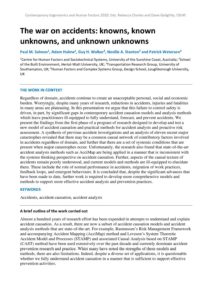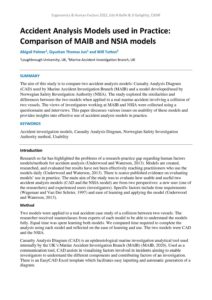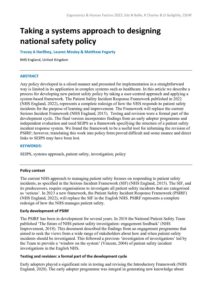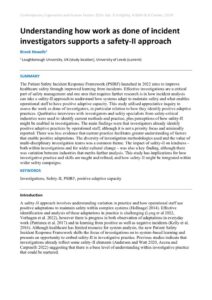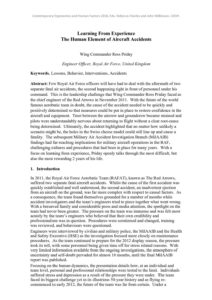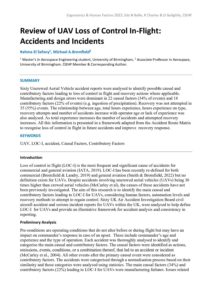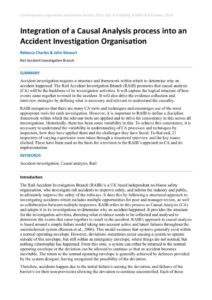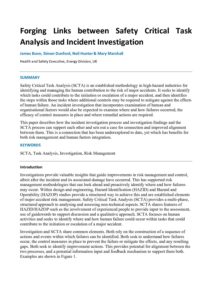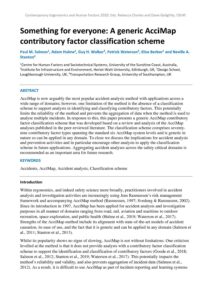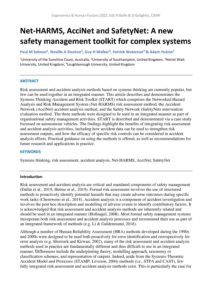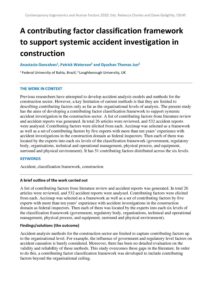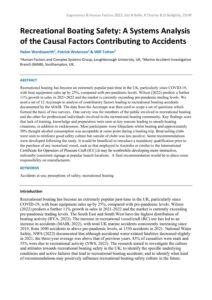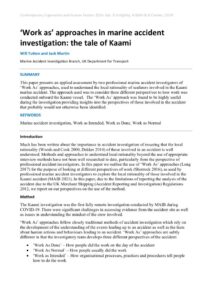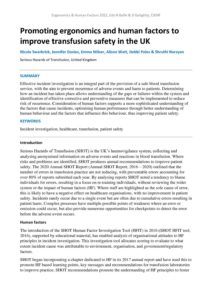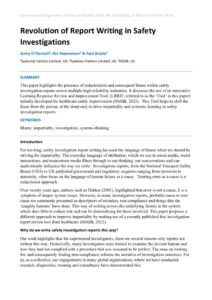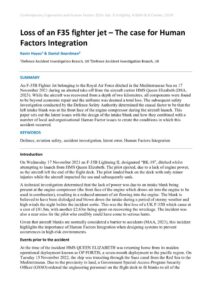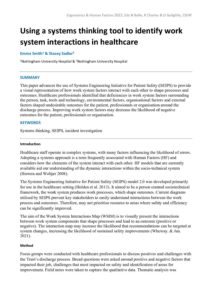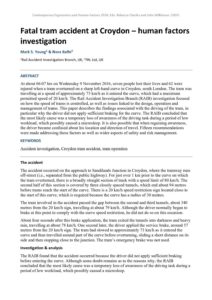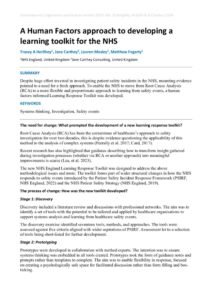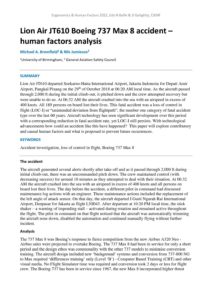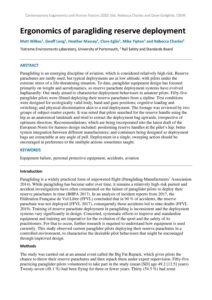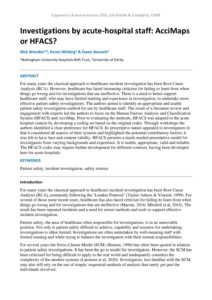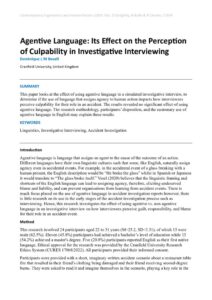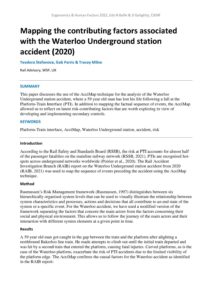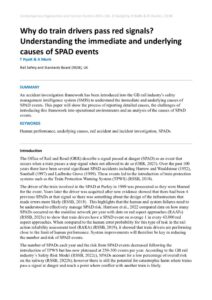Investigation
The war on accidents: knowns, known unknowns, and unknown unknowns
| Document | Author Paul M. Salmon, Adam Hulme, Guy H. Walker, Neville A. Stanton and Patrick Waterson |
| Abstract Regardless of domain, accidents continue to create an unacceptable personal, social and economic burden. Worryingly, despite many years of research, reductions in accidents, injuries and fatalities in many areas are plateauing. In this presentation we argue that this failure to control safety is driven, in part, by significant gaps in contemporary accident causation models and analysis methods which leave practitioners ill-equipped to fully understand, forecast, and prevent accidents. We present the findings from the first phase of a program of research designed to develop and test a new model of accident causation and practical methods for accident analysis and proactive risk assessment. A synthesis of previous accident investigations and an analysis of eleven recent major catastrophes revealed that there may be a common causal network of contributory factors involved in accidents regardless of domain, and further that there are a set of systemic conditions that are present when major catastrophes occur. Unfortunately, the research also found that state-of-the-art accident analysis methods such as AcciMap are being applied in a manner that is inconsistent with the systems thinking perspective on accident causation. Further, aspects of the causal texture of accidents remain poorly understood, and current models and methods are ill-equipped to elucidate them. These include the role of normal performance in accidents, migration of work practices, feedback loops, and emergent behaviours. It is concluded that, despite the significant advances that have been made to date, further work is required to develop more comprehensive models and methods to support more effective accident analysis and prevention practices. |
Accident Analysis Models used in Practice: Comparison of MAIB and NSIA models
| Document | Author Abigail Palmer, Gyuchan Thomas Jun & Will Tutton |
| Abstract The aim of this study is to compare two accident analysis models: Casualty Analysis Diagram (CAD) used by Marine Accident Investigation Branch (MAIB) and a model developed/used by Norwegian Safety Investigation Authority (NSIA). The study explored the similarities and differences between the two models when applied to a real marine accident involving a collision of two vessels. The views of investigators working at MAIB and NSIA were collected using a questionnaire and interviews. This paper discusses various issues on usability of these models and provides insights into effective use of accident analysis models in practice. |
Taking a systems approach to designing national safety policy
| Document | Author Tracey A Herlihey, Lauren Mosley & Matthew Fogarty |
| Abstract Any policy developed in a siloed manner and presented for implementation in a straightforward way is limited in its application in complex systems such as healthcare. In this article we describe a process for developing new patient safety policy by taking a user-centred approach and applying a system-based framework. The Patient Safety Incident Response Framework published in 2022 (NHS England, 2022), represents a complete redesign of how the NHS responds to patient safety incidents for the purpose of learning and improvement. The Framework will replace the current Serious Incident Framework (NHS England, 2015). Testing and revision were a formal part of the development cycle. The final version incorporates findings from an early adopter programme and independent evaluation and used SEIPS as a framework specifying the structure of a patient safety incident response system. We found the framework to be a useful tool for informing the revision of PSIRF; however, translating this work into policy form proved difficult and some nuance and direct links to SEIPS may have been lost. |
Understanding how work as done of incident investigators supports a safety-II approach
| Document | Author Brook Howells |
| Abstract The Patient Safety Incident Response Framework (PSIRF) launched in 2022 aims to improve healthcare safety through improved learning from incidents. Effective investigations are a critical part of safety management and one area that requires further research is in how incident analysis can take a safety-II approach to understand how systems adapt to maintain safety and what enables operational staff to have positive adaptive capacity. This study utilised appreciative inquiry to assess the work as done of investigators, in particular relation to how they identify positive adaptive practices. Qualitative interviews with investigators and safety specialists from safety-critical industries were used to identify current methods and practice, plus perceptions of how safety-II might be enabled in investigations. The main findings were that investigators already identify positive adaptive practices by operational staff, although it is not a priority focus and minimally reported. There was less evidence that current practice facilitates greater understanding of factors that enable positive adaptations. The diversity of investigation methodologies used and the value of multi-disciplinary investigation teams was a common theme. The impact of safety-II on kindness – both within investigations and for wider cultural change – was also a key finding, although there was variation between industries that merits further analysis. This study has implications for how investigative practice and skills are taught and refined, and how safety-II might be integrated within wider safety campaigns. |
Learning From Experience: The Human Element of Aircraft Accidents
| Document | Author Wing Commander Ross Priday |
| Abstract Few Royal Air Force officers will have had to deal with the aftermath of two separate fatal air accidents, the second happening right in front of personnel under his command. This is the leadership challenge that Wing Commander Ross Priday faced as the chief engineer of the Red Arrows in November 2011. With the future of the world famous aerobatic team in doubt, the cause of the accident needed to be quickly and positively determined so that measures could be put in place to restore confidence in the aircraft and equipment. Trust between the aircrew and groundcrew became strained and pilots were understandably nervous about returning to flight without a clear root-cause being determined. Ultimately, the accident highlighted that no matter how unlikely a scenario might be, the holes in the Swiss cheese model could still line up and cause a fatality. The subsequent Military Air Accident Investigation Branch (MilAAIB) findings had far-reaching implications for military aircraft operations in the RAF, challenging cultures and procedures that had been in place for many years. With a focus on learning from experience, Priday openly talks through the most difficult, but also the most rewarding 2 years of his life. |
Review of UAV Loss of Control In-Flight: Accidents and Incidents
| Document | Author Rahma El Safany, Michael A.Bromfield |
| Abstract Sixty Uncrewed Aerial Vehicle accident reports were analysed to identify possible causal and contributory factors leading to loss of control in flight and recovery actions where applicable. Manufacturing and design errors were dominant in 22 causal factors (34% of events) and 18 contributory factors (22% of events) (e.g. ingestion of precipitation). Recovery was not attempted in 35 (55%) events. The relationship between age, total hours experience, hours experience on type, recovery attempts and number of accidents increase with operator age or lack of experience was also analysed. As total experience increases the number of accidents and attempted recovery increases. All this information is presented in a framework adapted from the Accident Route Matrix to recognise loss of control in flight in future accidents and improve recovery response. |
Integration of a Causal Analysis process into an Accident Investigation Organisation
| Document | Author Rebecca Charles & John Stewart |
| Abstract Accident investigation requires a structure and framework within which to determine why an accident happened. The Rail Accident Investigation Branch (RAIB) promotes that causal analysis (CA) will be the backbone of its investigation activities. It will capture the logical structure of how events came together to result in the accident. It will also drive the evidence collection and interview strategies by defining what is necessary and relevant to understand the causality. RAIB recognises that there are many CA tools and techniques and encourages use of the most appropriate tools for each investigation. However, it is important to RAIB to define a discipline framework within which the relevant tools are applied and to strive for consistency in this across all investigations. Historically, there has been some variability in this. To achieve this consistency, it is necessary to understand the variability in understanding of CA processes and techniques by inspectors, how they have applied them and the challenges they have faced. To that end, 21 inspectors of varying experience were taken through a structured interview and the key issues elicited. These have been used as the basis for a revision to the RAIB’s approach to CA and its implementation. |
Forging Links between Safety Critical Task Analysis and Incident Investigation
| Document | Author James Bunn, Simon Dunford, Neil Hunter & Mary Marshall |
| Abstract Safety Critical Task Analysis (SCTA) is an established methodology in high-hazard industries for identifying and managing the human contribution to the risk of major accidents. It seeks to identify which tasks could contribute to the initiation or escalation of a major accident, and then identifies the steps within those tasks where additional controls may be required to mitigate against the effects of human failure. An incident investigation that incorporates examination of human and organisational factors would also be expected to examine where and how failures occurred, the efficacy of control measures in place and where remedial actions are required. This paper describes how the incident investigation process and investigation findings and the SCTA process can support each other and sets out a case for connection and improved alignment between them. This is a connection that has been underexplored to date, yet which has benefits for both risk management and human factors integration. |
Something for everyone: A generic AcciMap contributory factor classification scheme
| Document | Author Paul M. Salmon, Adam Hulme, Guy H. Walker, Patrick Waterson, Elise Berber and Neville A. Stanton |
| Abstract AcciMap is now arguably the most popular accident analysis method with applications across a wide range of domains; however, one limitation of the method is the absence of a classification scheme to support analysts in identifying and classifying contributory factors. This potentially limits the reliability of the method and prevents the aggregation of data when the method is used to analyse multiple incidents. In response to this, this paper presents a generic AcciMap contributory factor classification scheme that was developed based on a review and analysis of the AcciMap analyses published in the peer-reviewed literature. The classification scheme comprises seventy-nine contributory factor types spanning the standard six AcciMap system levels and is generic in nature so can be applied in any domain. To close we discuss the implications for accident analysis and prevention activities and in particular encourage other analysts to apply the classification scheme in future applications. Aggregating accident analyses across the safety critical domains is recommended as an important area for future research. |
Net-HARMS, AcciNet and SafetyNet: A new safety management toolkit for complex systems
| Document | Author Paul M Salmon, Neville A Stanton, Guy H Walker, Patrick Waterson & Adam Hulme |
| Abstract Risk assessment and accident analysis methods based on systems thinking are currently popular, but few can be used together in an integrated manner. This article describes and demonstrates the Systems Thinking Accident and Risk Toolkit (START) which comprises the Networked Hazard Analysis and Risk Management System (Net-HARMS) risk assessment method, the Accident Network (AcciNet) accident analysis method, and the Safety Network (SafetyNet) intervention evaluation method. The three methods were designed to be used in an integrated manner as part of organisational safety management activities. START is described and demonstrated via a case study focussed on autonomous vehicles. The findings highlight the benefits of integrating risk assessment and accident analysis activities, including how accident data can be used to strengthen risk assessment outputs, and how the efficacy of specific risk controls can be considered in accident analysis efforts. Practical guidance on using the methods is offered, as well as recommendations for future research and applications in practice. |
A contributing factor classification framework to support systemic accident investigation in construction
| Document | Author Anastacio Goncalves, Patrick Waterson and Gyuchan Thomas Jun |
| Abstract Previous researchers have attempted to develop accident analysis models and methods for the construction sector. However, a key limitation of current methods is that they are limited to describing contributing factors only as far as the organisational levels of analysis. The present study has the aims of developing a contributing factor classification framework to support systemic accident investigation in the construction sector. A list of contributing factors from literature review and accident reports was generated. In total 26 articles were reviewed, and 532 accident reports were analysed. Contributing factors were elicited from each. Accimap was selected as a framework as well as a set of contributing factors by five experts with more than ten years’ experience with accident investigations in the construction domain as federal inspectors. Then each of them was located by the experts into each six levels of the classification framework (government, regulatory body, organisations, technical and operational management, physical process, and equipment, surround and physical environment). It has 51 contributing factors distributed across the six levels. |
Recreational Boating Safety: A Systems Analysis of the Causal Factors Contributing to Accidents
| Document | Author Helen Wordsworth, Patrick Waterson & Will Tutton |
| Abstract Recreational boating has become an extremely popular past-time in the UK, particularly since COVID-19, with boat equipment sales up by 25%, compared with pre-pandemic levels. Wilson (2022) predicts a further 11% growth in sales in 2021-2022 and the market is currently exceeding pre-pandemic trading levels. We used a set of 12 Accimaps to analyse of contributory factors leading to recreational boating accidents documented by the MAIB. The data from the Accimaps was then used to scope a set of questions which formed the basis of two surveys. One survey was for members of the public involved in recreational boating and the other for professional individuals involved in the recreational boating community. Key findings were that lack of training, knowledge and preparation were seen as key reasons leading to unsafe boating situations, in addition to recklessness. Most participants wore lifejackets whilst boating and approximately 50% thought alcohol consumption was acceptable at some point during a boating trip. Boat/sailing clubs were seen to reinforce good safety culture but outside of clubs was less positive. Some recommendations were developed following the study. It would be beneficial to introduce a mandatory qualification prior to the purchase of any motorised vessel, such as that employed in Australia or similar to the International Certificate for Operators of Pleasure Craft (ICC).It may be worthwhile developing more interactive, nationally consistent signage at popular launch locations. A final recommendation would be to place some responsibility on manufacturers. |
‘Work as’ approaches in marine accident investigation: the tale of Kaami
| Document | Author Will Tutton and Jack Martin |
| Abstract This paper presents an applied assessment by two professional marine accident investigators of ‘Work As’ approaches, used to understand the local rationality of seafarers involved in the Kaami marine accident. The approach used was to consider three different perspectives to how work was conducted onboard the Kaami vessel. The ‘Work As’ approach was found to be highly useful during the investigation providing insights into the perspectives of those involved in the accident that probably would not otherwise been identified. |
Promoting ergonomics and human factors to improve transfusion safety in the UK
| Document | Author Nicola Swarbrick, Jennifer Davies, Emma Milser, Alison Watt, Debbi Poles & Shruthi Narayan |
| Abstract Effective incident investigation is an integral part of the provision of a safe blood transfusion service, with the aim to prevent recurrence of adverse events and harm to patients. Determining how an incident has taken place allows understanding of the gaps or failures within the system and identification of effective corrective and preventive measures that can be implemented to reduce risk of recurrence. Consideration of human factors supports a more sophisticated understanding of the factors that cause incidents, optimising human performance through better understanding of human behaviour and the factors that influence this behaviour, thus improving patient safety. |
Revolution of Report Writing in Safety Investigations
| Document | Author Jenny O’Donnell, Nic Steevenson & Paul Bowie |
| Abstract This paper highlights the presence of reductionism and consequent blame within safety investigation reports across multiple high-reliability industries. It discusses the use of an innovative Learning Response Review and Improvement Tool, (LRRIT, referred to as the ‘Tool’ in this paper) initially developed for healthcare safety improvement (HSSIB, 2023). This Tool helps to shift the focus from the person, at the sharp end, to drive impartiality and systemic learning in safety investigation reports. |
Loss of an F35 fighter jet – The case for Human Factors Integration
| Document | Author Kevin Hayes & Daniel Boardman |
| Abstract An F-35B Fighter Jet belonging to the Royal Air Force ditched in the Mediterranean Sea on 17 November 2021 during an aborted take-off from the aircraft carrier HMS Queen Elizabeth (DSA, 2023). While the aircraft was recovered from a depth of two kilometres, all components were found to be beyond economic repair and the airframe was deemed a total loss. The subsequent safety investigation conducted by the Defence Safety Authority determined the causal factor to be that the left intake blank was at the front face of the engine compressor during the aircraft launch. This paper sets out the latent issues with the design of the intake blank and how they combined with a number of local and organisational Human Factor issues to create the conditions in which this accident occurred. |
Using a systems thinking tool to identify work system interactions in healthcare
| Document | Author Emma Smith & Stacey Sadler |
| Abstract This paper advances the use of Systems Engineering Initiative for Patient Safety (SEIPS) to provide a visual representation of how work system factors interact with each other to shape processes and outcomes. Healthcare professionals identified that deficiencies in work system factors surrounding the person, task, tools and technology, environmental factors, organisational factors and external factors shaped undesirable outcomes for the patient, professionals or organisation around the discharge process. Improving work system factors may decrease the likelihood of negative outcomes for the patient, professionals or organisation. |
Fatal tram accident at Croydon – human factors investigation
| Document | Author Mark S. Young & Nora Balfe |
| Abstract At about 06:07 hrs on Wednesday 9 November 2016, seven people lost their lives and 62 were injured when a tram overturned on a sharp left-hand curve in Croydon, south London. The tram was travelling at a speed of approximately 73 km/h as it entered the curve, which had a maximum permitted speed of 20 km/h. The Rail Accident Investigation Branch (RAIB) investigation focused on how the speed of trams is controlled, as well as issues linked to the design, operation and management of trams. This paper describes the findings associated with the driving of the tram, in particular why the driver did not apply sufficient braking for the curve. The RAIB concluded that the most likely cause was a temporary loss of awareness of the driving task during a period of low workload, which possibly caused a microsleep. It is also possible that when regaining awareness, the driver became confused about his location and direction of travel. Fifteen recommendations were made addressing these factors as well as wider aspects of safety and risk management. |
A Human Factors approach to developing a learning toolkit for the NHS
| Document | Author Tracey A Herlihey, Jane Carthey, Lauren Mosley, Matthew Fogarty |
| Abstract Despite huge effort invested in investigating patient safety incidents in the NHS, mounting evidence pointed to a need for a fresh approach. To enable the NHS to move from Root Cause Analysis (RCA) to a more flexible and proportionate approach to learning from safety events, a human factors informed Learning Response Toolkit was developed. |
Lion Air JT610 Boeing 737 Max 8 accident – human factors analysis
| Document | Author Michael A. Bromfield & Nils Jamieson |
| Abstract Lion Air JT610 departed Soekarno-Hatta International Airport, Jakarta Indonesia for Depati Amir Airport, Pangkal Pinang on the 29th of October 2018 at 06:20 AM local time. As the aircraft passed through 2,000 ft during the initial climb-out, it pitched down and the crew attempted recovery but were unable to do so. At 06:32 AM the aircraft crashed into the sea with an airspeed in excess of 400 knots. All 189 persons on board lost their lives. This fatal accident was a loss of control in flight (LOC-I) or “unintended deviation from flightpath”, the number one category of fatal accident type over the last 60 years. Aircraft technology has seen significant development over this period with a corresponding reduction in fatal accident rate, yet LOC-I still persists. With technological advancements how could an accident like this have happened? This paper will explore contributory and causal human factors and what is proposed to prevent future occurrences. |
Ergonomics of paragliding reserve deployment
| Document | Author Matt Wilkes, Geoff Long, Heather Massey, Clare Eglin, Mike Tipton and Rebecca Charles |
| Abstract Paragliding is an emerging discipline of aviation, which is considered relatively high risk. Reserve parachutes are rarely used, but typical deployments are at low altitude, with pilots under the extreme stress of a life-threatening situation. To date, paraglider equipment design has focused primarily on weight and aerodynamics, so reserve parachute deployment systems have evolved haphazardly. Our study aimed to characterise deployment behaviours in amateur pilots. Fifty-five paraglider pilots were filmed deploying their reserve parachutes from a zipline. Test conditions were designed for ecologically valid body, hand and gaze positions; cognitive loading and switching; and physical disorientation akin to a real deployment. The footage was reviewed by two groups of subject matter experts. It was noted that pilots searched for the reserve handle using the hip as an anatomical landmark and tried to extract the deployment bag upwards, irrespective of optimum direction. Recommendations, which are being incorporated into the latest draft of the European Norm for harness design included: positioning reserve handles at the pilot’s hip; better system integration between different manufacturers; and containers being designed so deployment bags are extractable at any angle of pull. Deployment in a single, sweeping action should be encouraged in preference to the multiple actions sometimes taught. |
Investigations by acute-hospital staff: AcciMaps or HFACS?
| Document | Author Nick Woodier, Karen Whiting & Owen Bennett |
| Abstract For many years the classical approach to healthcare incident investigation has been Root Cause Analysis (RCA). However, healthcare has faced increasing criticism for failing to learn from when things go wrong and for investigations that are ineffective. There is a need to better support healthcare staff, who may have limited training and experience in investigation, to undertake more effective patient safety investigations. The authors aimed to identify an appropriate and usable patient safety investigation method for use by healthcare staff. The result of a literature review and engagement with experts led the authors to focus on the Human Factors Analysis and Classification System (HFACS) and AcciMap. Prior to evaluating the methods, HFACS was adapted to the acute hospital context by developing a coding set based on the original codes. Through workshops the authors identified a clear preference for HFACS. Its prescriptive nature appealed to investigators in that it considered all aspects of their systems and highlighted the potential contributory factors; it was felt to have face and content validity. HFACS presents a much-needed prescriptive model for investigators from varying backgrounds and experience. It is usable, appropriate, valid and reliable. The HFACS codes may require further development for different contexts, having been developed here for acute hospitals. |
Agentive Language: Its Effect on the Perception of Culpability in Investigative Interviewing
| Document | Author Dominique L M Bovell |
| Abstract This paper looks at the effect of using agentive language in a simulated investigative interview, to determine if the use of language that assigns agency to human action impacts how interviewees perceive culpability for their role in an accident. The results revealed no significant effect of using agentive language. The research methodology, participants’ disposition, and the customary use of agentive language in English may explain these results. |
Mapping the contributing factors associated with the Waterloo Underground station accident (2020)
| Document | Author Teodora Stefanova, Gab Parris & Tracey Milne |
| Abstract This paper discusses the use of the AcciMap technique for the analysis of the Waterloo Underground station accident, where a 59 year old man has lost his life following a fall at the Platform-Train Interface (PTI). In addition to mapping the factual sequence of events, the AcciMap allowed us to reflect on latent risk-contributing factors that are worth exploring in view of developing and implementing secondary controls. |
Why do train drivers pass red signals? Understanding the immediate and underlying causes of SPAD events
| Document | Author T Hyat & A Monk |
| Abstract An accident investigation framework has been introduced into the GB rail industry's safety management intelligence system (SMIS) to understand the immediate and underlying causes of SPAD events. This paper will show the process of reporting detailed causes, the challenges of introducing this framework into operational environments and an analysis of the causes of SPAD events. |

